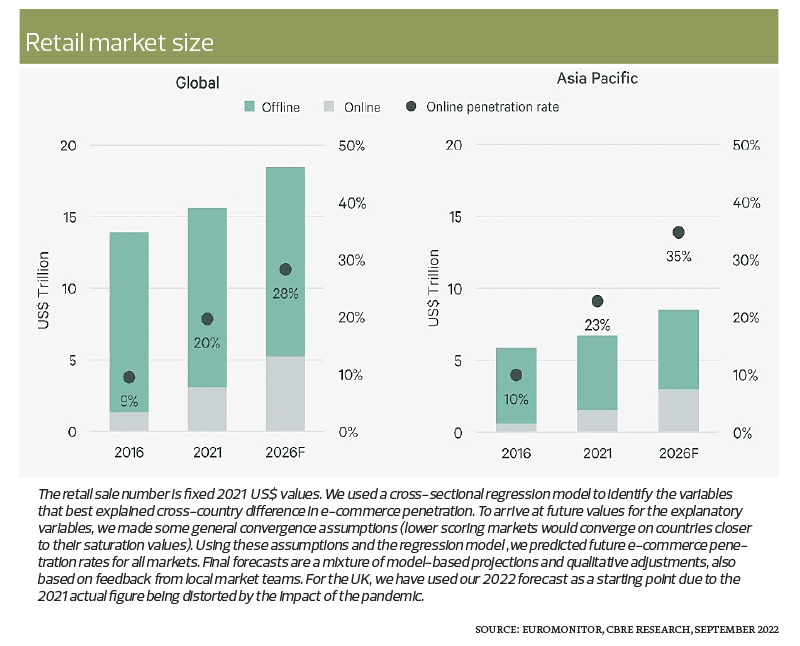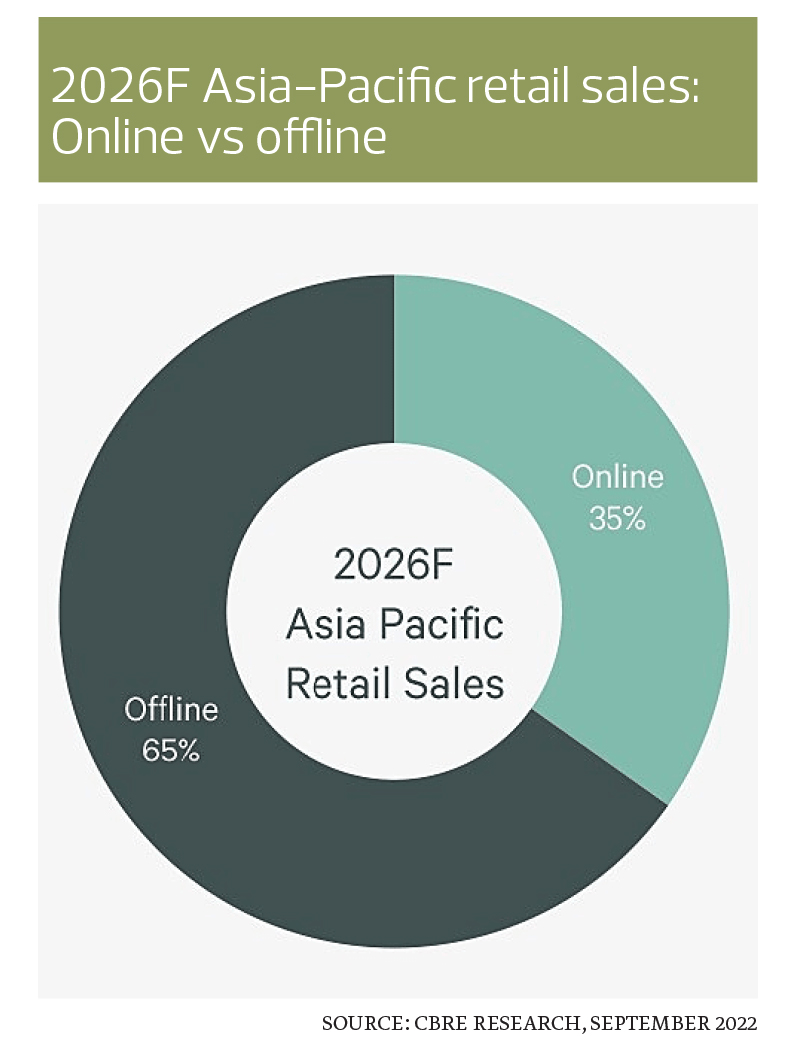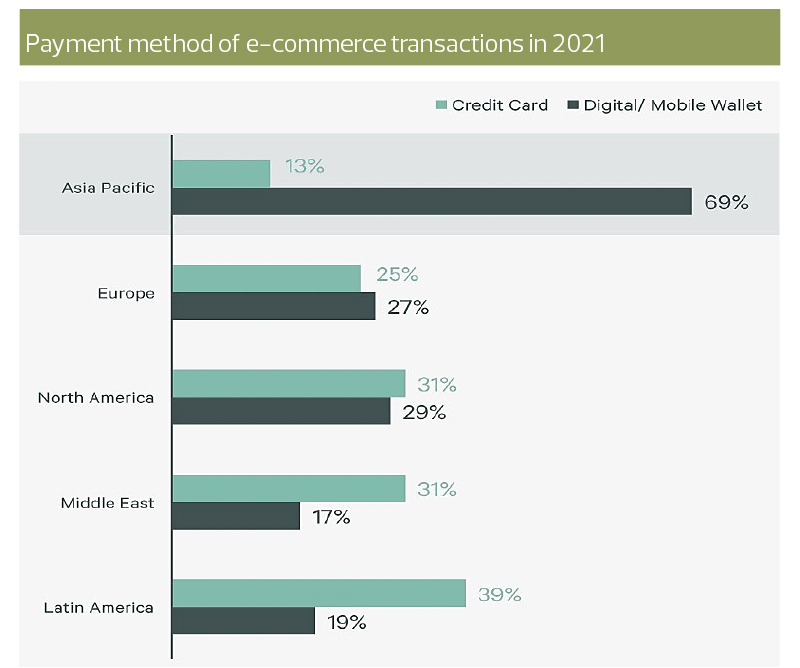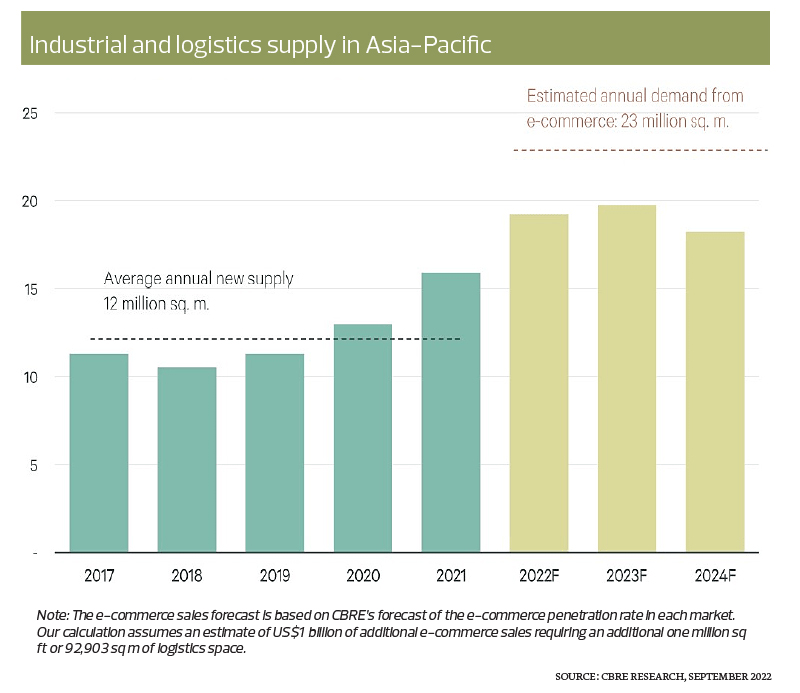
This article first appeared in City & Country, The Edge Malaysia Weekly on January 9, 2023 - January 15, 2023
Asia-Pacific accounted for 40% of the US$15.6 trillion (RM69 trillion) global retail market in 2021, according to the CBRE Research October 2022 report, “Omnichannel Retail and its Impact on Asia Pacific Real Estate”.
As a result, CBRE expects the growth of e-commerce in Asia-Pacific to outpace the rest of the world. The growth forecast is based on the fact that Asia-Pacific has a distinct advantage in three out of six factors that determine the extent of e-commerce penetration.
The factors are: (i) the percentage of urban population; (ii) mobile internet sales ratio; (iii) debit and credit card plus digital wallet usage; (iv) digital technology skills; (v) dominant e-commerce player; and (vi) fixed broadband subscriptions.
The three main advantages enjoyed by the region are the continual growth in the urban population, adoption of digital payment methods and increased investment in new infrastructure and marketing strategies.
Growth of e-commerce in Asia-Pacific
The first factor is that the region continues to see strong growth in its urban population, especially in mega-city clusters. The report explains that between 2020 and 2030, the urban population of Asia-Pacific is forecast to expand by 320 million, with growth being led by emerging economies such as mainland China, Southeast Asia and India.
Additionally, the report says, markets experiencing organic population growth will also see strong domestic migration to major metropolitan areas. “Authorities in secondary cities are expected to pursue a proactive approach towards talent retention and attraction by offering preferential policies and incentives.
“With urbanisation continuing apace, emerging economies will see rising numbers of shoppers armed with substantial consumption power … there continues to be solid consumption from the region’s growing middle-class population,” says the report.
The outbreak of Covid-19 encouraged widespread adoption of digital payments solutions in the region. The report says: “Despite the limited availability of banking services in rural areas, the prevalence of affordable smartphones has enabled consumers in emerging markets to partake in e-commerce and utilise digital wallets.”
Concurrently, many local e-commerce platforms in Asia-Pacific have introduced their own digital wallets. Malaysians widely use Touch ’n Go eWallet, GrabPay and Boost eWallet, among others. Mainland China uses Alipay and WeChat Pay, people in Hong Kong SAR use PayMe, India uses paytm and PhoPe, PayPay is popular in Japan, while South Koreans use Samsung Pay and Naver Pay. A large majority of Southeast Asian countries use GoPay, Gcash, ShopeePay and SMART Money.
Markets with large young populations, according to the report, are seeing faster growth in terms of digital wallet usage. In 2021, digital/mobile wallet usage in Asia-Pacific stood at a whopping 69%, while Europe had 27%, North America 29%, the Middle East 17% and Latin America 19%.
Finally, the region’s e-commerce ecosystem is expanding as domestic and regional e-commerce platforms are investing heavily in new infrastructure and marketing. The report highlights that intense competition among local e-commerce platforms has stimulated investment in consumer education, experience and infrastructure, which in turn has facilitated the growth of the e-commerce market.
By predicting the evolution of the six e-commerce drivers over time, CBRE has formulated a 2026 forecast for the e-commerce penetration rate in each market. Based on its forecast, Asia-Pacific’s penetration rate will rise to 35% by 2026.
This penetration rate, however, will vary across different product categories. “Clothing, especially value products, and consumer electronics will remain the two most penetrated categories. Groceries will see the strongest growth following strong uptake among consumers since the onset of the pandemic.
“CBRE expects more retailers to set up their own direct-to-consumer e-commerce channels to reduce reliance upon third-party marketplaces. This will ensure retailers gain more and better customer data that can be leveraged to develop more targeted online sales and marketing strategies,” the report says.
Need for bricks-and-mortar retail
Meanwhile, the report notes that bricks-and-mortar retail will continue to dominate the retail market. Although online retail is expected to expand further and increase overall market share, CBRE forecasts offline sales will remain the dominant retail sales channel in 2026, covering 65% of the retail market.
In recent years, there has been a steady increase in customer acquisition costs for online retail. Such costs refer to the resources and costs incurred to acquire additional customers.
Concurrently, retail rents in many markets have been flat or fallen sharply since the onset of the pandemic, the report notes.
Discussions with retailers revealed that most firms continue to regard bricks-and-mortar stores as their key sales channels, and that these stores are also deemed more effective in engaging customers and cross-selling. In the future, these stores are set to evolve from being a location where transactions are made to a hub that provides a comprehensive customer experience.
The report lists three evolving functions of bricks-and-mortar stores. To better facilitate sales transactions, stores could hire more sales associates to assist customers, have more goods on display and set up dedicated areas for testers.
For an enhanced in-store experience, the report suggests retailers provide food and beverage (F&B) offers, install unique designs and host in-store events. Luxury brands have been taking the lead in this approach, with athletic apparel now embracing it as well.
To improve the fulfilment of the consumer experience, more retailers will introduce click-and-collect services, which may also attract more foot traffic to stores and facilitate easier returns. Some retailers may also fulfil small batches of online orders using in-store inventory.
The report says this model has been widely adopted by F&B operators with the rise of online order platforms and on-demand delivery apps. The increase in online grocery shopping during the pandemic had encouraged large supermarkets to follow suit.
CBRE also shared four methods that omnichannel stores can adopt to facilitate online spending and reduce logistics costs. The click-and-collect method allows shoppers to buy goods online and pick them up at a physical store. “This has been widely adopted by major offline-based retailers as it encourages consumers to visit stores and potentially spend more,” the report says.
In-store online purchases allow consumers to buy either online or in-store and get home delivery services. Electrical and furniture retailers have led the use of this model. Today, more general retailers are assisting consumers in performing online orders in-store and arranging direct shipments. “This approach can reduce in-store inventory while enabling consumers to enjoy hands-free shopping,” says the report.
Other than that, showrooming allows consumers to try a product before making the actual purchase. Based on the report, many retailers now place a small volume of online-only goods in bricks-and-mortar stores to let consumers touch and test products before ordering. This model, the report adds, helps reduce returns of online purchases.
In-store returns allow consumers to buy goods online but return them in-store. By offering in-store returns, retailers can expect consumers to spend more time in their physical stores, which would also help shorten restocking periods and lower the cost of reverse logistics.
Reinventing retail for omnichannel
With omnichannel retail on the rise, many traditional bricks-and-mortar retailers are considering new formats and locations for their businesses. At the same time, digital native retailers are setting up physical stores.
One way of doing this is by adopting new store formats. For example, IKEA enables consumers to use mobile apps or in-store computers to browse and order products for home delivery.
Another way is by responding to community needs, like Japanese fast fashion retailer Uniqlo, which has been opening mega-sized stores in suburban areas that also serve as leisure destinations for consumers.
Then, there is the shift from online to offline as is the case with Love, Bonito. The brand began as an online fashion retailer in Singapore and has since expanded into bricks-and-mortar retailing. “The retailer first opened its flagship store in its home market in 2017 and subsequently added shops in neighbouring countries such as Malaysia, Indonesia and Cambodia. After testing the market with a pop-up store in 2019, the retailer opened its first permanent store in Hong Kong SAR this year,” the report explains.
Apart from retailers, landlords who are looking to reinvent themselves for omnichannel can work on reviewing their performance metrics with tenants to explore ways to “tailor rental formats according to the nature of their tenants’ businesses”.
Landlords can also boost retailtainment offerings by adjusting their tenant mix according to the changes in consumer demand. The report suggests introducing more retailers in service trades such as healthcare and beauty, as well as retailtainment such as art studios and specialist fitness centres.
Deepening customer engagement by leveraging mobile apps can also create stronger communication with consumers. “Specific initiatives may include extending exclusive offers to premium customers to encourage repeat shopping and tailored marketing based on users’ search terms and interests. Other steps can include incorporating data from membership apps and social media into [the] evaluation of store performance to better measure the impact of their tenants,” the report says.
Demand for logistics space
With the increase in e-commerce supply chain operations, the report notes that demand for warehouse and logistics space has risen as well. In Asia-Pacific, CBRE expects the competition among distributors and retailers for modern high-quality logistics space to intensify.
Based on CBRE’s analysis, every US$1 billion of additional e-commerce sales requires an additional one million sq ft of logistics space. Following this calculation, it predicts Asia-Pacific will require an additional 100 million to 130 million sq m of logistics space for e-commerce operations.
Based on the report, logistics availability has tightened considerably since the onset of the pandemic, with most Asia-Pacific markets reporting a vacancy rate of under 5% in June 2022. As a result, the report expects the region to see an increase in logistics supply from 2022 to 2024.
CBRE has estimated annual demand for logistics space of 23 million sq m for the e-commerce sector from 2022 to 2024. At the same time, it is expected that Asia-Pacific will see an increase in logistics space supply with new completions averaging 20 million sq m from 2022 to 2024. The report adds that this will be below the annual average of structural demand that is required by the e-commerce sector estimated by CBRE.
The report provides two solutions to solve the lack of logistics supply. The first is the build-to-suit strategy, whereby the landlord constructs an asset to meet the particular needs of a company. This model, the report says, is also popular in markets where land and construction costs are high or if there is heightened interest from institutional investors and developers.
The second solution is to invest in logistics technologies. CBRE advises occupiers to invest in technologies such as automated storage/retrieval systems and automated guided vehicles, in order to improve operational efficiency that requires lesser space to accommodate sales growth.
Save by subscribing to us for your print and/or digital copy.
P/S: The Edge is also available on Apple's App Store and Android's Google Play.
- Gas pipeline blaze: MIDF flags potential RM18m impact to Petronas Gas
- Gas pipeline blaze: Petronas Gas, Gas Malaysia’s shares open marginally lower after trading halt
- T7 Global drops to two-year low, triggers short-selling halt after deputy chairman's departure
- Digital banks in Malaysia urged to re-examine strategies to better serve B40 segment
- Yinson's shares slip, analysts tell investors to look past underwhelming results
- Gas pipeline fire: No abnormalities detected by air quality monitoring stations — DOE
- A supply chain quirk helped Air India get 50 Boeing jets made for Chinese carriers
- Police to investigate contractor in connection with gas pipeline fire at Putra Heights
- New law subjects 17 Singapore transport firms to greater govt scrutiny
- India's March palm oil imports rise but stay below normal levels, dealers say




